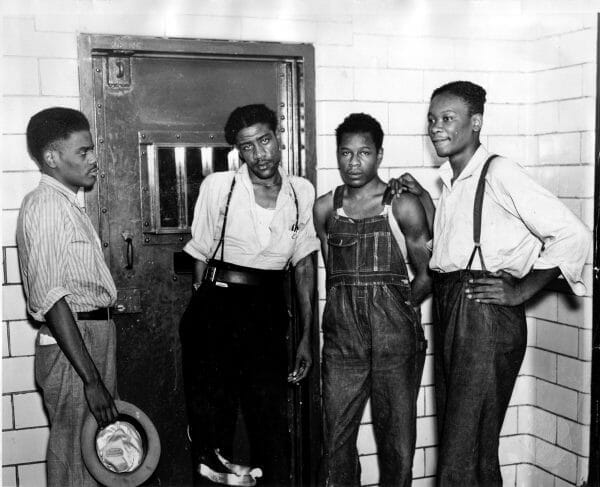James Horton Jr.
James Edwin Horton Jr. (1878-1973), an otherwise obscure circuit court judge presiding in Limestone County, gained renown for his courageous decision to set aside the verdict and death sentence of Haywood Patterson, who was one of the nine men accused of raping two white women in 1931 in the notorious Scottsboro Trials. The trials gained international attention and resulted in two significant decisions of the U.S. Supreme Court.
The son of James Edwin Horton Sr., also a judge, and Emily Donelson Horton, James Horton was born on January 4, 1878, in Tennessee. Horton’s mother was the great niece of Pres. Andrew Jackson. During his childhood, Horton moved with his parents to Athens, Limestone County. Although not much is known of Horton’s early life, he was reportedly a sickly child and did not start school until he was about eight or nine years old. Horton did well enough in school thereafter and was accepted into Vanderbilt University’s medical studies program. After only a year at Vanderbilt, he transferred to Cumberland University in Lebanon, Tennessee, where he obtained his BA degree in 1897. Two years later, he obtained a law degree from the Cumberland School of Law.
Horton began his legal career by clerking for his father, who was the probate judge for Limestone County, after which he entered into private practice. In 1910, he was elected to the Alabama House of Representatives, in which he served until 1914 and then in the Alabama Senate for one term before he left to become chancery court judge in Limestone County. In 1922, he was elected as a circuit court judge for the Eighth Judicial Circuit, which at that time consisted of four counties in north-central Alabama, including his home county of Limestone. In the early 1920s, Horton married Anna Hobbs Horton, with whom he had two sons: James Edwin Horton III and Donelson Branch Horton. He was elected for a second term as a circuit court judge in 1928.
The first trials of the Scottsboro defendants, including Patterson’s, had been conducted in just four days in early April 1931 in Scottsboro, the seat of Jackson County. The trials attracted so menacing a crowd of angry whites that the sheriff requested that Gov. Benjamin Miller deploy the Alabama National Guard to prevent potential lynchings. Not surprisingly, all nine defendants received guilty verdicts, and eight of the nine were sentenced to death.
 Scottsboro Defendants
In 1933, Horton was assigned to preside over the retrial of lead defendant Haywood Patterson. The announcement was met with general approval, with the local press praising his legal ability and fairness, and the lead prosecutor, Alabama Attorney General Thomas Knight, declared that Horton would make a superb judge. The prosecution’s weak case had faltered since the first set of trials, when one of the alleged victims recanted her testimony and acknowledged that she had made up the allegations to avoid charges that she had crossed state lines for immoral purposes. The testimony of the remaining alleged victim at the beginning of Patterson’s second trial caused Judge Horton to have serious doubts about the prosecution’s case. These doubts were only strengthened after he heard the medical testimony of one of the examining physicians. Horton then became suspicious when at the last moment the other examining physician was not called by the prosecution. In a private meeting with Horton, the physician revealed that he was convinced that the alleged victims were lying, but he declined Horton’s plea to testify because of his fear of reprisals. The jury found Patterson guilty and again imposed the death penalty.
Scottsboro Defendants
In 1933, Horton was assigned to preside over the retrial of lead defendant Haywood Patterson. The announcement was met with general approval, with the local press praising his legal ability and fairness, and the lead prosecutor, Alabama Attorney General Thomas Knight, declared that Horton would make a superb judge. The prosecution’s weak case had faltered since the first set of trials, when one of the alleged victims recanted her testimony and acknowledged that she had made up the allegations to avoid charges that she had crossed state lines for immoral purposes. The testimony of the remaining alleged victim at the beginning of Patterson’s second trial caused Judge Horton to have serious doubts about the prosecution’s case. These doubts were only strengthened after he heard the medical testimony of one of the examining physicians. Horton then became suspicious when at the last moment the other examining physician was not called by the prosecution. In a private meeting with Horton, the physician revealed that he was convinced that the alleged victims were lying, but he declined Horton’s plea to testify because of his fear of reprisals. The jury found Patterson guilty and again imposed the death penalty.
On June 22, 1933, Horton stunned the courtroom when he granted the defendant’s motion to set aside the verdict because of his firm belief that it was not supported by substantial evidence. In a point-by-point review of the evidence, Horton emphasized that the testimony of the only remaining victim was contradictory and unreliable. As a result of his findings, Horton ordered a new trial. Displeased with this ruling, the Alabama Supreme Court took Horton off the case. Patterson was tried and convicted for a third and then a fourth time, finally escaping from jail in 1948 to achieve his freedom.
The courage exhibited by Horton in the Patterson trial cost him re-election to a third term as a circuit court judge in May 1934. He had run unopposed in his previous election. After the election, Horton retired from politics and devoted the rest of his life to the private practice of law and to farming. In March 1934, Horton sold his homestead in Athens to the Tennessee Valley Authority, which needed his land for the Wheeler Dam construction project. However, he had his antebellum family home on that land taken apart and reassembled in Greenbrier, a small community in southeastern Limestone County. There he raised cotton, corn, soybeans, and a large herd of Aberdeen-Angus cattle.
Horton died on March 28, 1973, at the age of 95 and was interred in the Athens City Cemetery. Shortly after his death, county officials installed a plaque in Horton’s old courtroom that quoted his instruction to the jury in the Patterson case: “So far as the law is concerned it knows neither native nor alien, Jew nor Gentile, black nor white. This case is no different from any other. We have only to do our duty without fear or favor.”
Horton was posthumously elected to the Alabama Lawyers Hall of Fame in 2010 by the Alabama State Bar. In October 2017, the city of Athens dedicated a statue of Horton in front of the Limestone County Courthouse.
Further Reading
- Linder, Douglas O. “Without Fear or Favor: Judge James Edwin Horton and the Trial of the ‘Scottsboro Boys’.” University of Missouri Kansas-City Law Review 68 (Summer 2000).
- Reidy, Thomas. “Awaiting Justice: ‘Scottsboro Boy’ Clarence Norris” Alabama Heritage 105 (Summer 2012): 22-29.



